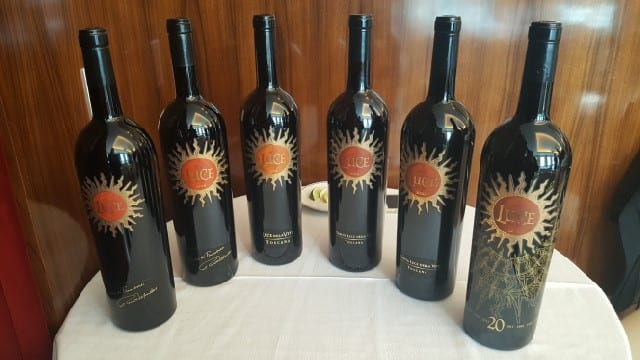
13 Sep The Shining Light of Luce: Reflections on the past and looking towards the future
This story originally appeared in the Napa Valley Register.
For 700 years and 30 generations, the Frescobaldi family has been an iconic name in the wine industry. With an eye on celebrating the diversity of Tuscany’s terroir, the family owns six estates in Tuscany and produces what some consider to be some of Italy’s finest wines.
One of these wines is Luce della Vita from the hill town of Montalcino. A region famous for its Brunello di Montalcino, Luce della Vita was the first winery to blend sangiovese and merlot. The idea was to produce a wine that blended the Old World and New World together, with the traditional sangiovese offering structure and elegance and the non-traditional merlot adding roundness and smoothness. Luce Della Vite, “the light of life”, is a winery that is steeped in tradition while embracing the future.
Luce della Vita was created in 1995, initially as a collaboration between two great winemaking families, Marchese de Frescobaldi and Robert Mondavi. Today, the winery is under the sole proprietorship of Lamberto Frescobaldi. The Luce della Vita estate is located southwest of the medieval town of Montalcino. The first vineyards were purchased in 1996, with additional vineyards purchased in 2001 and 2016. Today, there are 88 hectares planted to merlot and sangiovese on southwest-facing vineyards with mixed-clay, sandy schistose and sandstone soils.
The symbol of Luce della Vita honors the traditions of the Frescobaldi family and the history of the Montalcino region. The image of the sun was used as a decorative motif in Renaissance art. Luce della Vita’s sun is the color of a dark red, alluding to the red soils of Siena. The sun has 12 flames surrounding it, inspired by Brunelleschi’s drawings of the high altar of Florence’s Church of Santo Spirito built in the 16th century on land given to the city by the Frescobaldi family.
While the logo of Luce della Vita looks to the past, the winery is looking to the future with a new cellar and a new winemaker this year. The new underground cellar is located in the center of the vineyard plot and has a central corridor that is considered the backbone of the winery. In fact, from the renderings shown, the corridor looks like a dinosaur spine with an uneven curved ceiling that has arches at varying heights. There are three openings along the corridor that connect to the wine library, which has been built on classical geometry rule and is in harmony with the territory.
As the new winery is scheduled to officially open in 2017, this year’s harvest will also bring a new winemaking team. Stefano Ruini is the new technical director and enologist. After earning his degree in viticulture and enology at the University of Paicenza, Ruini spent three decades working in the Medoc region in Bordeaux. He returned to Italy with the knowledge he gained in Bordeaux but is focused on the terroir.
“We make terroir wine, not technological wine,” he explained. “To understand the nature as it envelops us, we must look at it through its eyes.”
While 2017 will be Ruini’s first vintage, and his influence on the wines is yet to be discovered, a recent tasting took us back through the history of the winery. Luca della Vita is always a 50/50 blend of sangiovese and merlot, allowing the terroir and the uniqueness of each vintage to shine.
— Luce 1997 – A vintage that suffered a freeze, the wine has notes of dried raspberry and cranberry, cloves and soft tannins.
— Luce 1999 – A good vintage, the wine is a dense ruby color with ripe aromas of plum, raisin, blackberry, brown sugar, brown spices and velvety tannins.
— Luce 2006 – Another good vintage, the wine is dense, dark purple with a nose of dried plum, brown spices, vanilla, licorice, dark chocolate and tobacco. With drying tannins, this wine still has a lot of aging to do.
— Luce 2008 – The hot vintage was good for the late ripening sangiovese but the merlot was a little overripe. The wine is a dense purple color with concentrated aromas of wild blackberry, sour cherry, pepper and tobacco.
— Luce 2010 – A difficult year with a wet spring followed by a good fall leading up to harvest, this wine is a purple-red color with notes of wild berry fruit, currants, blackberry, brown spices. The nose is perfumed, almost like a cologne and the wine is full of big tannins.
— Luce 2012 – Spring rains were followed by an ideal dry summer and the resulting wine is a dark ruby color with a big, deep, complex nose of wild blackberry, cloves, pepper and licorice with a hint of smokiness.
Read the original story in the Napa Valley Register.
Discover more from Please The Palate
Subscribe to get the latest posts sent to your email.




